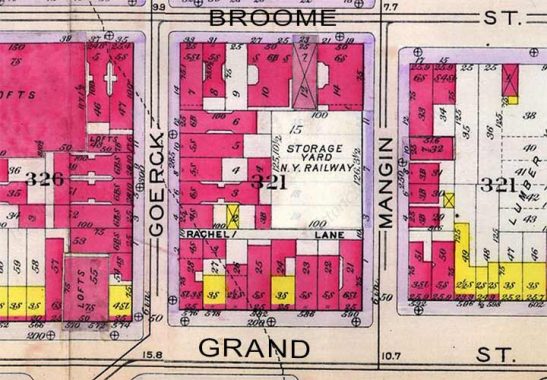
In no other Manhattan neighborhood has the street map changed more greatly over the decades than the Lower East Side, more specifically the easternmost section known as Corlears Hook, where both the island’s coastline and the East River make a sharp turn to the north. In recent years, NYC Parks has closed its major oasis of green, East River Park, killing it so they can save it, so to speak, as a new storm surge barrier is built to hedge against flooding caused by global warming (it’s 90 degrees as I type this on May 21st; incidental, I know).
I digress. Corlears Hook formerly had a very tight grid of streets jammed with overcrowded tenements and industrial works on its eastern end. As this article in The Lower East Side History Project explains, in addition to being crowded it was also dangerous as street gangs divided it into territories …
Continuing down the renamed Jackson Street, you spot one of the numerous, decrepit, docks lining the foggy East River. Chatter and wicked laughter can be heard throughout the thick sea air, as you peek under Pier 57. Encamped around a small fire divvying up loot is the murderous Short Tails Gang.
Headquartered on the corner of Rivington Street and Goerck Street (today’s Baruch Playground), the Short Tails terrorized the Corlears Hook docks by robbing, beating or murdering incoming boats and sailors. Not wanting to get involved with such a brutal crew, you walk along Cherry Street only to encounter the Daybreak Boys, the greatest of the East River pirate gangs. Known for sabotaging boats in early morning hours, they are rumored to be responsible for up to 40 murders in a two year period. Further down the waterfront, Patsy Conroy has recruited some of the most infamous thieves to inherit the mantle as the most dangerous gang in Corlears hook. Luckily, the failed Mattan Robbery would be the undoing of this gang.
In the name of “slum clearance” hundreds of the tenements and industrial works were removed and the familiar “towers in a park” concept was hatched, with the largest such in the area being the Seward Park Houses and Baruch Houses. A number of streets were wiped off the map. Recently, I took a walk around the area and surprisingly a number of these streets have had small pieces preserved or have left their mark in other ways; but that’s another page, another day.

Today, I want to hone in on a tiny alley that has vanished, named Rachel Lane (the street name sounds like it would belong to a woman who writes children’s books). It can be seen on this map produced in 1909; today, this entire acreage is covered by the Corlears Hook Houses and only Grand Street is still in existence.

As this excerpt from the City Record in November 1903 (is it still published?) demonstrates, Rachel Lane was laid out in the spot shown on the 1909 map that year, and built shortly thereafter. It survived until the Houses went up in the 1950s. The question is, why was such a short street commissioned, and who was the Rachel it was named for? Unanswerable questions, at this remove.
(Note: Commenters have found references to Rachel’s Lane as early as 1853! See below)
This 1949 Hagstrom map shows Rachel Lane (circled) but does not name it; space limitations sometimes prohibited the mapmaker from showing everything. You can see the original street layout is under transition as already the Vladeck Houses have taken out some streets south of Grand.
I’ve never found a photo of Rachel Lane but this 1940 view of #8 Goerck (later renamed Baruch Place; a short piece remains) comes tantalizingly close, as you can see its curb cut and a very short piece of it. In the background you can see the Williamsburg Bridge approach over Delancey Street.
As always, “comment…as you see fit.” I earn a small payment when you click on any ad on the site.
5/21/22